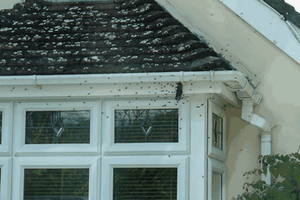Dealing with Wasps and Hornet nests safely.
Safe Treatment of Wasp or Hornet Nests.
Understanding the potential dangers of addressing a wasp nest is essential. While we don't want to cause panic, it's crucial to emphasize that doing so without proper training and experience can be risky.
We often come across nests that homeowners have tampered with in an attempt to solve the problem on their own. However, most DIY treatments fail, and the DIYer often gets stung. It is natural to want to handle the problem yourself, but it is better to seek professional help.
Many people try to block the entrance to the nest with expanding foam or silicone sealant, but this can worsen the situation. We cannot emphasise enough: DO NOT BLOCK THE ENTRANCE TO A WASP OR HORNET NEST. It is essential to understand that each nest is unique, and predicting their behaviour is difficult. All types of social wasps are defensive and can attack people without provocation, even at a distance from the nest.
Therefore, it is best to seek the help of trained professionals to handle these situations safely and effectively.

Are wasps aggressive after being treated?
After treating a nest, it is expected to observe a sudden surge in the number of wasps or hornets around the entrance. This happens because the insecticide is injected under pressure into the nest, which causes a reaction from both the wasps inside and those returning to the nest.
The injection process triggers temporary agitation and aggression among the wasps as they become aware of the disturbance. The initial treatment reduces the pheromone emitted by the queen and masks the peptide trail into the nest. Consequently, returning wasps may find it difficult to detect the nest's scent, leading to a momentary state of alarm or surprise when they return.
After treatment, there is usually a brief accumulation of wasps outside the nest entrance. However, this typically settles down within about 20 minutes as the wasps resume their usual entry into the nest. The size of the nest determines the magnitude of this post-treatment buildup; larger nests tend to result in more wasps backing up at the entrance.
As the treated wasps re-enter the nest, they inadvertently distribute the insecticide, which affects all occupants. We suggest customers close nearby windows and doors and avoid the nest area for a short time following treatment.

Dealing with dead Wasps or Hornets after treatment.
After treating a wasp or hornet nest with insecticide, it's common to see a sudden increase in the number of these insects around the entrance. This happens because the insecticide is injected under pressure into the nest, which agitates the insects and causes them to come out. It's important to remember that even though the wasps or hornets may be dead, their stingers can still pose a risk if stepped on barefoot.
Finding dead wasps on the ground, especially in grass or dense foliage, can be difficult. This is why proactive measures are essential, especially for families with children. Making sure that children wear protective footwear while playing outside after a nest treatment is crucial. By doing so, we can reduce the risk of accidentally stepping on unseen, dead wasps and provide a safer environment for outdoor activities.
How to deal with a Wasp or Hornet nest inside a house.
If you're dealing with wasps entering your home, locating their entry points is important. Small gaps or holes can often be used as access points, and you can temporarily close them with tape until a professional can treat the nest.
Take a good look around the exterior of your home, paying close attention to increased wasp activity, which can help you pinpoint the nest's location. You can also watch our wasp nest identification video for guidance on identifying key indicators.
Inspect areas where wasps may enter, such as holes in ceilings where pipes pass through, poorly fitting loft hatches, or even some light fittings. Remember that, like many insects, wasps are attracted to light. Gaps in the ceiling that allow light to shine into the loft space at night can draw wasps, especially with older-style downlights that emit light upwards and downwards.
In more severe cases, particularly in older homes, wasps and hornets may build nests inside the house and go unnoticed until residents start getting stung. If this happens, it's best to locate the area or room where the nest is and keep everyone out of that room as a precaution by opening windows and closing doors.
Call us immediately
Allergic reaction to wasp or hornet stings.
As emphasized throughout this website, it is important to understand that wasp and hornet stings can cause Anaphylactic Shock in some individuals. Allergic reactions to venom from these insects can only be determined after being stung. Anaphylactic shock is a severe allergic reaction that can be life-threatening and cause low blood pressure and lung inflammation.
If you are stung and feel unwell, it is crucial to seek immediate medical attention. Delaying medical intervention can be risky. Recognizing the symptoms promptly and taking swift action to manage this severe condition effectively is essential. Symptoms may include difficulty breathing, swelling, and a drop in blood pressure. Seeking immediate medical help increases the chances of receiving the necessary treatment to alleviate symptoms and prevent further complications.
